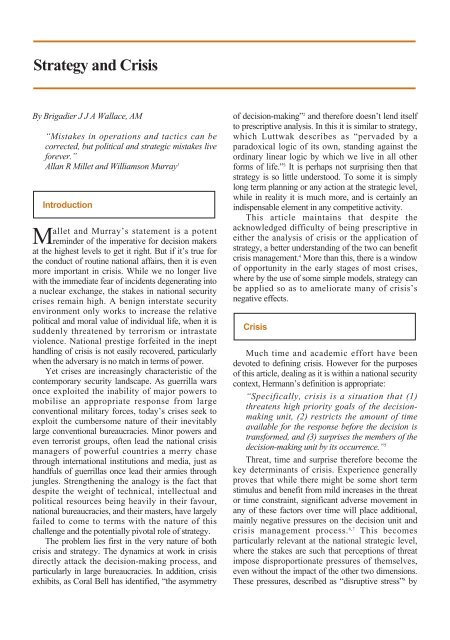ISSUE 136 : May/Jun - 1999 - Australian Defence Force Journal
ISSUE 136 : May/Jun - 1999 - Australian Defence Force Journal
ISSUE 136 : May/Jun - 1999 - Australian Defence Force Journal
- No tags were found...
You also want an ePaper? Increase the reach of your titles
YUMPU automatically turns print PDFs into web optimized ePapers that Google loves.
Strategy and CrisisBy Brigadier J J A Wallace, AM“Mistakes in operations and tactics can becorrected, but political and strategic mistakes liveforever.”Allan R Millet and Williamson Murray 1IntroductionMallet and Murray’s statement is a potentreminder of the imperative for decision makersat the highest levels to get it right. But if it’s true forthe conduct of routine national affairs, then it is evenmore important in crisis. While we no longer livewith the immediate fear of incidents degenerating intoa nuclear exchange, the stakes in national securitycrises remain high. A benign interstate securityenvironment only works to increase the relativepolitical and moral value of individual life, when it issuddenly threatened by terrorism or intrastateviolence. National prestige forfeited in the inepthandling of crisis is not easily recovered, particularlywhen the adversary is no match in terms of power.Yet crises are increasingly characteristic of thecontemporary security landscape. As guerrilla warsonce exploited the inability of major powers tomobilise an appropriate response from largeconventional military forces, today’s crises seek toexploit the cumbersome nature of their inevitablylarge conventional bureaucracies. Minor powers andeven terrorist groups, often lead the national crisismanagers of powerful countries a merry chasethrough international institutions and media, just ashandfuls of guerrillas once lead their armies throughjungles. Strengthening the analogy is the fact thatdespite the weight of technical, intellectual andpolitical resources being heavily in their favour,national bureaucracies, and their masters, have largelyfailed to come to terms with the nature of thischallenge and the potentially pivotal role of strategy.The problem lies first in the very nature of bothcrisis and strategy. The dynamics at work in crisisdirectly attack the decision-making process, andparticularly in large bureaucracies. In addition, crisisexhibits, as Coral Bell has identified, “the asymmetryof decision-making” 2 and therefore doesn’t lend itselfto prescriptive analysis. In this it is similar to strategy,which Luttwak describes as “pervaded by aparadoxical logic of its own, standing against theordinary linear logic by which we live in all otherforms of life.” 3 It is perhaps not surprising then thatstrategy is so little understood. To some it is simplylong term planning or any action at the strategic level,while in reality it is much more, and is certainly anindispensable element in any competitive activity.This article maintains that despite theacknowledged difficulty of being prescriptive ineither the analysis of crisis or the application ofstrategy, a better understanding of the two can benefitcrisis management. 4 More than this, there is a windowof opportunity in the early stages of most crises,where by the use of some simple models, strategy canbe applied so as to ameliorate many of crisis’snegative effects.CrisisMuch time and academic effort have beendevoted to defining crisis. However for the purposesof this article, dealing as it is within a national securitycontext, Hermann’s definition is appropriate:“Specifically, crisis is a situation that (1)threatens high priority goals of the decisionmakingunit, (2) restricts the amount of timeavailable for the response before the decision istransformed, and (3) surprises the members of thedecision-making unit by its occurrence.” 5Threat, time and surprise therefore become thekey determinants of crisis. Experience generallyproves that while there might be some short termstimulus and benefit from mild increases in the threator time constraint, significant adverse movement inany of these factors over time will place additional,mainly negative pressures on the decision unit andcrisis management process. 6,7 This becomesparticularly relevant at the national strategic level,where the stakes are such that perceptions of threatimpose disproportionate pressures of themselves,even without the impact of the other two dimensions.These pressures, described as “disruptive stress” 8 by

















